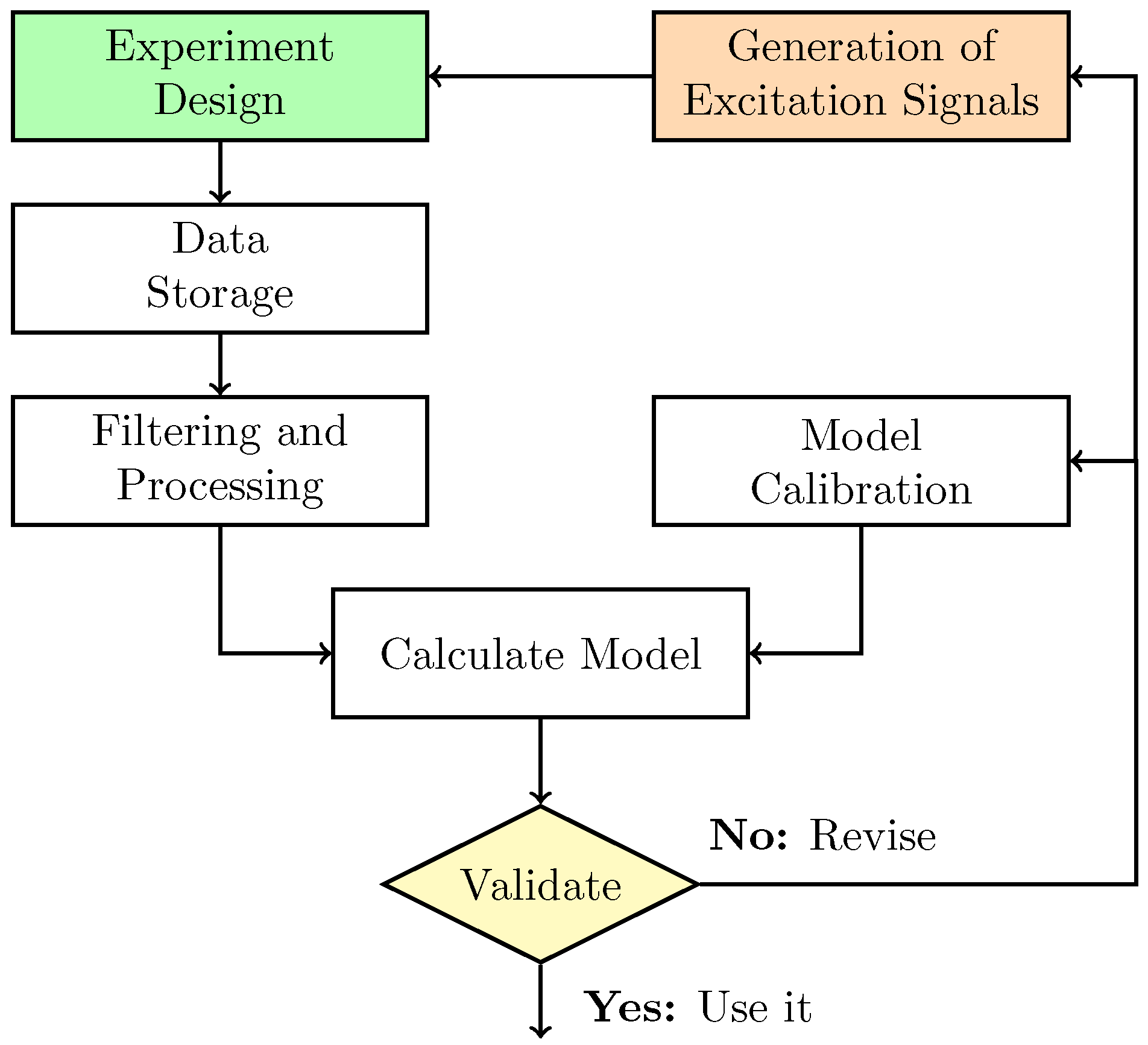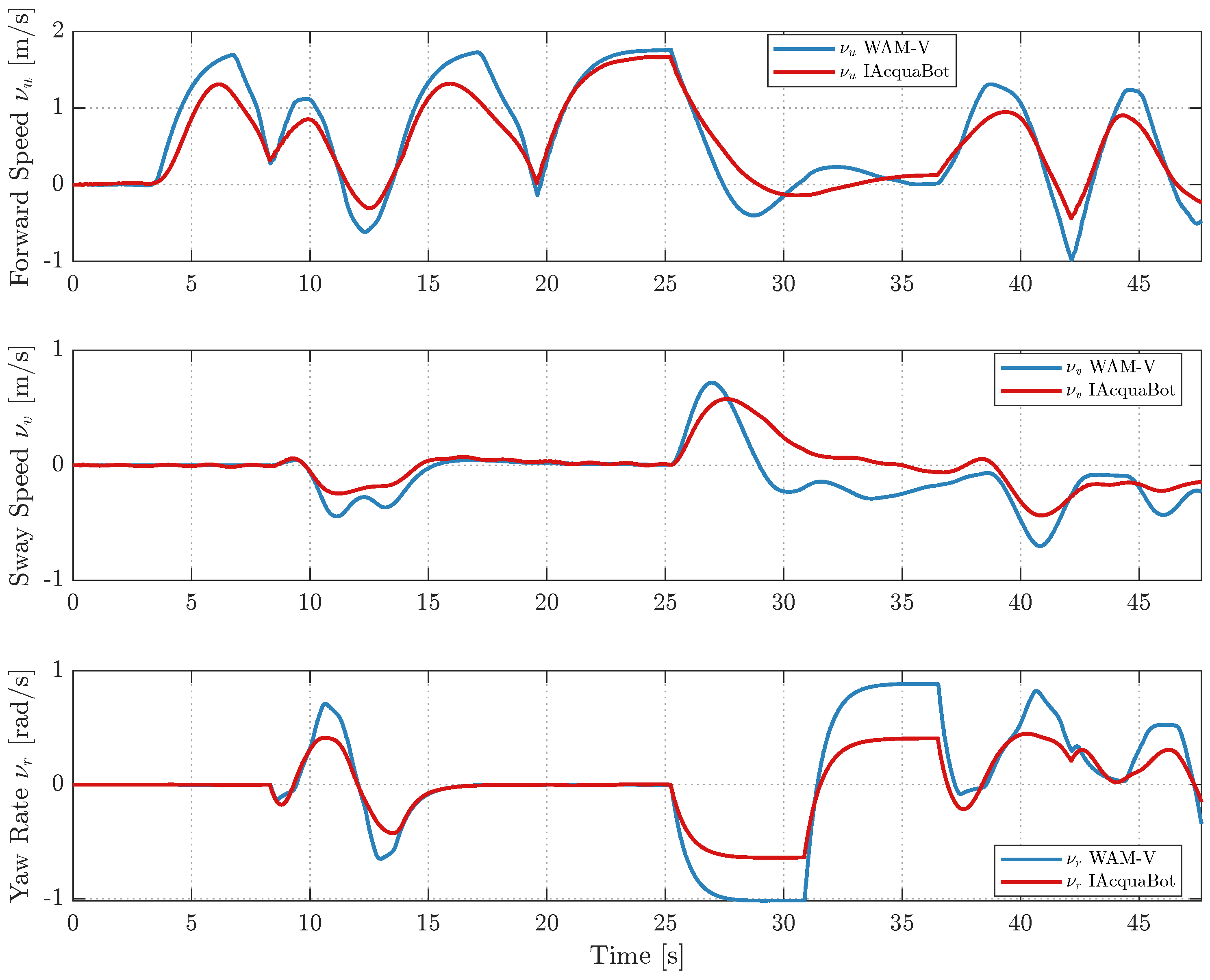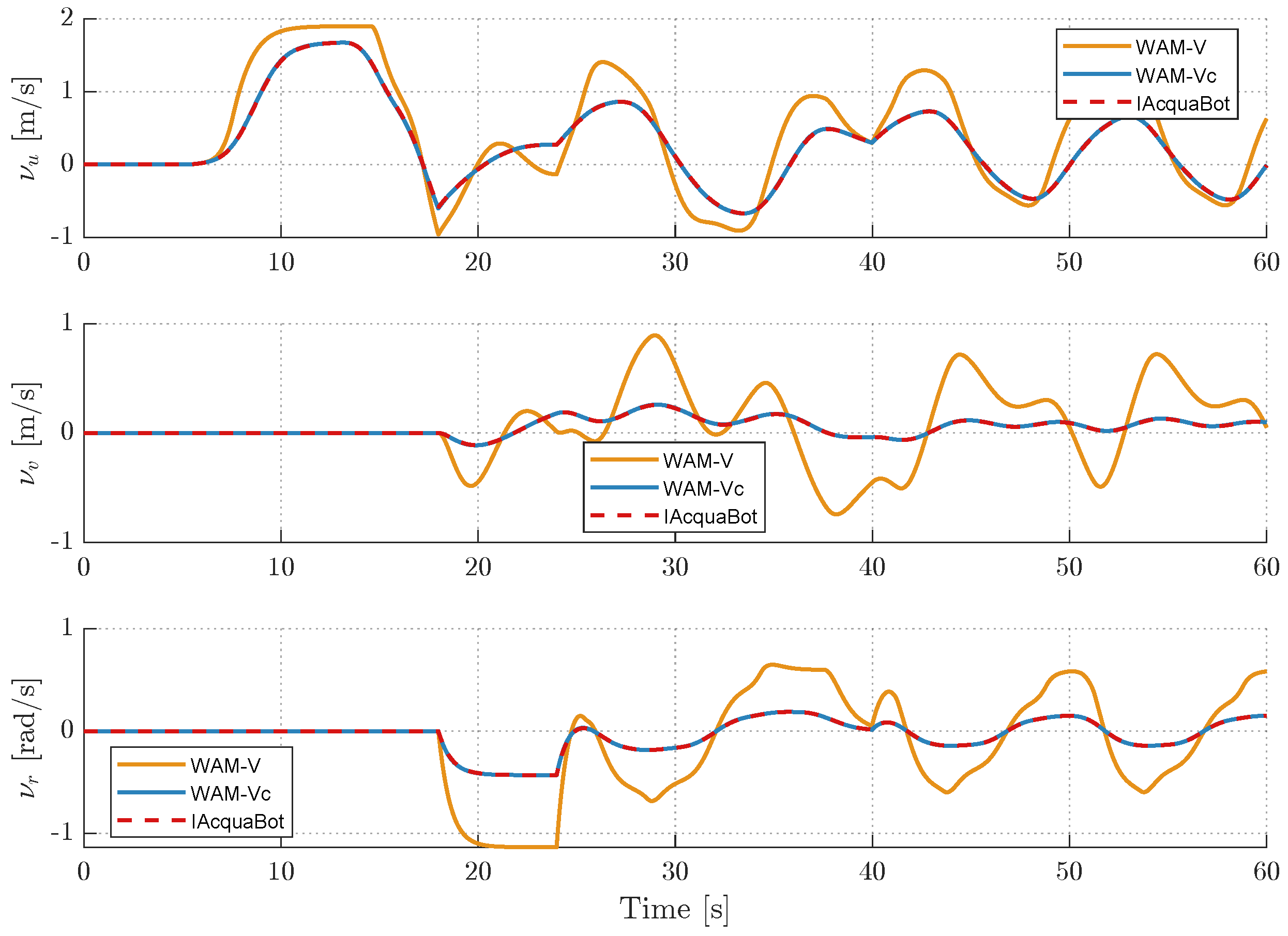A Novel Methodology for Designing Digital Models for Mobile Robots Based on Model-Following Simulation in Virtual Environments
Abstract
1. Introduction
1.1. Related Works
1.2. Main Contributions
1.3. Paper Outline
2. Materials and Methods
Dynamic Model Formulation Based on Fossen’s Approach
3. System Identification
LQS-Based Parameter Estimation
4. Model-Following Strategy
Proposed Closed-Loop Model Following Architecture
5. Results
5.1. Analysis of Results
5.2. Future Work
6. Conclusions
Author Contributions
Funding
Data Availability Statement
Acknowledgments
Conflicts of Interest
Abbreviations
| USV | Unmanned Surface Vehicle |
| VRX | Virtual RobotX (simulation for autonomous vehicle competitions) |
| WAM-V | Wave Adaptive Modular Vessel |
| DTs | Digital Twins |
| DMs | Digital Models |
| UAV | Unmanned Aerial Vehicle |
| UGV | Unmanned Ground Vehicle |
| LQS | Least Quadratic Squares |
| DOF | Degrees of Freedom |
| CI | Confidence Intervals |
| STD | Standard Deviations |
| RMSE | Root Mean Square Error |
| MAE | Mean Absolute Error |
| R2 | Coefficient of Determination |
| SiTL | Software-in-the-Loop |
| HiTL | Hardware-in-the-Loop |
Appendix A

References
- Kritzinger, W.; Karner, M.; Traar, G.; Henjes, J.; Sihn, W. Digital Twin in Manufacturing: A Categorical Literature Review and Classification. IFAC-PapersOnLine 2018, 51, 1016–1022. [Google Scholar] [CrossRef]
- Sepasgozar, S.M.E. Differentiating Digital Twin from Digital Shadow: Elucidating a Paradigm Shift to Expedite a Smart, Sustainable Built Environment. Buildings 2021, 11, 151. [Google Scholar] [CrossRef]
- Barbie, A.; Hasselbring, W. From Digital Twins to Digital Twin Prototypes: Concepts, Formalization, and Applications. IEEE Access 2024, 12, 75337–75365. [Google Scholar] [CrossRef]
- MathWorks. What Is Hardware-in-the-Loop (HIL)? 2025. Available online: https://www.mathworks.com/discovery/hardware-in-the-loop-hil.html (accessed on 12 August 2025).
- DJI. DJI Software Development Kit (SDK). 2025. Available online: https://developer.dji.com (accessed on 12 August 2025).
- Sagitov, A.; Gerasimov, Y. Towards DJI Phantom 4 Realistic Simulation with Gimbal and RC Controller in ROS/Gazebo Environment. In Proceedings of the 2017 10th International Conference on Developments in eSystems Engineering (DeSE), Paris, France, 14–16 June 2017; pp. 262–266. [Google Scholar] [CrossRef]
- Speirs, P.J.; Renker, M.; Aulenbacher, U.; Wellig, P.; Murk, A. High-Detail X-Band RCS Simulations of a DJI S900 Hexacopter, and Comparisons Against Measurements. In Proceedings of the 2021 21st International Radar Symposium (IRS), Berlin, Germany, 21–22 June 2021; pp. 1–10. [Google Scholar] [CrossRef]
- Parrot. Parrot SDK and Simulation Environment. 2025. Available online: https://developer.parrot.com (accessed on 12 August 2025).
- Giernacki, W. Iterative Learning Method for In-Flight Auto-Tuning of UAV Controllers Based on Basic Sensory Information. Appl. Sci. 2019, 9, 648. [Google Scholar] [CrossRef]
- Nandkumar, C.; Shukla, P.; Varma, V. Simulation of Indoor Localization and Navigation of Turtlebot 3 Using Real Time Object Detection. In Proceedings of the 2021 International Conference on Disruptive Technologies for Multi-Disciplinary Research and Applications (CENTCON), Bengaluru, India, 19–21 November 2021; pp. 222–227. [Google Scholar] [CrossRef]
- Ma, C.; Zhou, Y.; Li, Z. A New Simulation Environment Based on AirSim, ROS, and PX4 for Quadcopter Aircrafts. In Proceedings of the 2020 6th International Conference on Control, Automation and Robotics (ICCAR), Singapore, 20–23 April 2020; pp. 486–490. [Google Scholar] [CrossRef]
- Niit, E.A.; Smit, W.J. Integration of Model Reference Adaptive Control (MRAC) with PX4 Firmware for Quadcopters. In Proceedings of the 2017 24th International Conference on Mechatronics and Machine Vision in Practice (M2VIP), Auckland, New Zealand, 21–23 November 2017; pp. 1–6. [Google Scholar] [CrossRef]
- Jung, S.; Kim, Y.J. MILS and HILS Analysis of Power Management System for UAVs. IEEE Access 2023, 11, 79240–79255. [Google Scholar] [CrossRef]
- Clearpath Robotics. Clearpath Simulator. 2025. Available online: https://docs.clearpathrobotics.com/docs/ros/tutorials/simulator/overview/ (accessed on 12 August 2025).
- Morales, J.; Castelo, I.; Serra, R.; Lima, P.U.; Basiri, M. Vision-Based Autonomous Following of a Moving Platform and Landing for an Unmanned Aerial Vehicle. Sensors 2023, 23, 829. [Google Scholar] [CrossRef] [PubMed]
- Stan, A.C. A Decentralised Control Method for Unknown Environment Exploration Using Turtlebot 3 Multi-Robot System. In Proceedings of the 2022 14th International Conference on Electronics, Computers and Artificial Intelligence (ECAI), Ploiesti, Romania, 30 June–1 July 2022; pp. 1–6. [Google Scholar] [CrossRef]
- PX4 Development Team. PX4 USV Simulator—Archived Project Note. 2023. Available online: https://docs.px4.io (accessed on 12 August 2025).
- Cyberbotics. Heron USV Simulation Model in Webots. 2025. Available online: https://cyberbotics.com (accessed on 12 August 2025).
- Bingham, B.; Agüero, C.; McCarrin, M.; Klamo, J.; Malia, J.; Allen, K.; Lum, T.; Rawson, M.; Waqar, R. Toward Maritime Robotic Simulation in Gazebo. In Proceedings of the OCEANS 2019 MTS/IEEE Seattle, Seattle, WA, USA, 27–31 October 2019; pp. 1–10. [Google Scholar] [CrossRef]
- Wu, X.; Wei, C. DRL-Based Motion Control for Unmanned Surface Vehicles with Environmental Disturbances. In Proceedings of the 2023 IEEE International Conference on Unmanned Systems (ICUS), Hefei, China, 13–15 October 2023; pp. 1696–1700. [Google Scholar] [CrossRef]
- Li, J.; Chavez-Galaviz, J.; Azizzadenesheli, K.; Mahmoudian, N. Dynamic Obstacle Avoidance for USVs Using Cross-Domain Deep Reinforcement Learning and Neural Network Model Predictive Controller. Sensors 2023, 23, 3572. [Google Scholar] [CrossRef] [PubMed]
- Chen, L.; Liu, C.; Guo, S.; Qian, H. Vision-Guided UAV Landing on a Swaying Ocean Platform in Simulation. In Proceedings of the 2023 IEEE International Conference on Real-time Computing and Robotics (RCAR), Datong, China, 17–20 July 2023; pp. 456–462. [Google Scholar] [CrossRef]
- Bayrak, M.; Bayram, H. COLREG-Compliant Simulation Environment for Verifying USV Motion Planning Algorithms. In Proceedings of the Oceans 2023—Limerick, Limerick, Ireland, 5–8 June 2023; pp. 1–10. [Google Scholar] [CrossRef]
- Campos, D.F.; Matos, A.; Pinto, A.M. Multi-domain Inspection of Offshore Wind Farms Using an Autonomous Surface Vehicle. SN Appl. Sci. 2021, 3, 455. [Google Scholar] [CrossRef]
- Li, C.; Yao, L.; Lu, Y.; Zhang, S.; Zhang, T. DTL-GNN: Digital Twin Lightweight Method Based on Graph Neural Network. Future Internet 2025, 17, 65. [Google Scholar] [CrossRef]
- Stączek, P.; Pizoń, J.; Danilczuk, W.; Gola, A. A Digital Twin Approach for the Improvement of an Autonomous Mobile Robots (AMR’s) Operating Environment—A Case Study. Sensors 2021, 21, 7830. [Google Scholar] [CrossRef] [PubMed]
- Li, R.; Shang, X.; Wang, Y.; Liu, C.; Song, L.; Zhang, Y.; Gu, L.; Zhang, X. Research on Parameter Compensation Method and Control Strategy of Mobile Robot Dynamics Model Based on Digital Twin. Sensors 2024, 24, 8101. [Google Scholar] [CrossRef] [PubMed]
- Betzer, J.S.; Boudjadar, J.; Frasheri, M.; Talasila, P. Digital Twin Enabled Runtime Verification for Autonomous Mobile Robots under Uncertainty. arXiv 2024, arXiv:2412.09913. [Google Scholar] [CrossRef]
- Cheng, C.; Zhang, H.; Sun, Y.; Tao, H.; Chen, Y. A Cross-Platform Deep Reinforcement Learning Model for Autonomous Navigation without Global Information in Different Scenes. Control Eng. Pract. 2024, 150, 105991. [Google Scholar] [CrossRef]
- Fossen, T.I. Handbook of Marine Craft Hydrodynamics and Motion Control; Wiley: Oxford, UK, 2021. [Google Scholar]
- Carelli, R.; Secchi, H.; Mut, V. Algorithms for Stable Control of Mobile Robots with Obstacle Avoidance. Lat. Am. Appl. Res. 1999, 29, 191–196. [Google Scholar]










| Simulation Level | Description |
|---|---|
| Numerical representation | Mathematical models implemented in tools like MATLAB/Simulink, describing dynamics through equations without spatial rendering or physics. |
| Digital Mockup | Geometric visualization using mesh files (e.g., .STL) for appearance and layout, without physics-based interaction. |
| Structural Model | Robot structure with links, joints, and kinematics (URDF/SDF), enabling collision detection and articulation without dynamic simulation. |
| Software-in-the-Loop (SITL) | Simulation including actual control software running in a virtual environment that emulates robot sensors and actuators, enabling the testing of software logic without hardware. |
| Hardware-in-the-Loop (HITL) | Integration of physical hardware components with simulation; the controller runs on the real robot hardware (plant), while sensors and actuators are simulated. |
| Digital Model | Physics-based model with calibrated geometric and dynamic properties, not synchronized in real time with the physical system. |
| Digital Shadow | Real-time digital representation updated from physical sensor data, without feedback to the real system. |
| Digital Twin | Real-time bidirectional replica of the physical system, enabling monitoring, control, and predictive optimization. |
| Feature | WAM-V | IAcquaBot |
|---|---|---|
| Length [m] | 4.9 | 1.5 |
| Width [m] | 2.3 | 0.67 |
| Mass [kg] | 180 | 21 |
| Hull Type | Modular with mechanical suspension | Single rigid body, flat-bottomed |
| Thruster coordinates (body frame) [m] | Left: ; Right: | Top Left: ; Top Right: ; Back Left: ; Back Right: |
| Max thrust per thruster [N] | ||
| Min thrust per thruster [N] |
| Velocity Component | RMSE | MAE | R2 |
|---|---|---|---|
| Forward speed u [m/s] | 0.25840 | 0.20668 | 0.86794 |
| Sway speed v [m/s] | 0.15799 | 0.10405 | 0.51773 |
| Yaw rate r [rad/s] | 0.21584 | 0.13807 | 0.79921 |
| IAcquaBot | |||
|---|---|---|---|
| Symbol | Estimate | 95% CI | STD |
| 124.5923 | [123.9456, 125.2389] | 0.3299 | |
| 120.0275 | [118.7015, 121.3535] | 0.6765 | |
| 141.5164 | [140.9026, 142.1302] | 0.3132 | |
| 25.9335 | [25.0368, 26.8303] | 0.4575 | |
| 35.9833 | [35.2669, 36.6996] | 0.3655 | |
| 37.0247 | [34.1923, 39.8570] | 1.4451 | |
| 25.7968 | [21.0590, 30.5346] | 2.4172 | |
| 200.2944 | [198.1114, 202.4775] | 1.1138 | |
| 18.5319 | [15.3741, 21.6898] | 1.6111 | |
| WAM-V | |||
| Symbol | Estimate | 95% CI | STD |
| 125.9712 | [125.4830, 126.4593] | 0.2490 | |
| 121.4476 | [120.2338, 122.6614] | 0.6193 | |
| 70.5019 | [69.9934, 71.0104] | 0.2594 | |
| 26.5692 | [25.5330, 27.6054] | 0.5287 | |
| 35.8778 | [35.2117, 36.5440] | 0.3399 | |
| 36.4337 | [33.3414, 39.5260] | 1.5777 | |
| 27.4138 | [22.6374, 32.1903] | 2.4369 | |
| 99.1686 | [97.1265, 101.2107] | 1.0419 | |
| 10.6007 | [8.2782, 12.9233] | 1.1849 | |
| IAcquaBot | WAM-V | |||||
|---|---|---|---|---|---|---|
| State | RMSE | MAE | R2 | RMSE | MAE | R2 |
| [m/s] | 0.03714 | 0.03111 | 0.99548 | 0.04508 | 0.03519 | 0.99598 |
| [m/s] | 0.01254 | 0.00984 | 0.99541 | 0.01314 | 0.00880 | 0.99666 |
| [rad/s] | 0.00956 | 0.00644 | 0.99887 | 0.01714 | 0.01025 | 0.99873 |
| [m] | 0.32232 | 0.26361 | 0.99847 | 0.11266 | 0.09312 | 0.99988 |
| [m] | 0.13300 | 0.11067 | 0.99774 | 0.33700 | 0.28346 | 0.97451 |
| [rad] | 0.01699 | 0.01276 | 0.99976 | 0.02663 | 0.01918 | 0.99974 |
| State | RMSE | MAE | ||||
|---|---|---|---|---|---|---|
| WAM-V | WAM-Vc | WAM-V | WAM-Vc | WAM-V | WAM-Vc | |
| [m/s] | 0.3596 | 0.0048 | 0.2830 | 0.0038 | 0.6120 | 0.99993 |
| [m/s] | 0.2850 | 0.0017 | 0.1995 | 0.0012 | 0.99953 | |
| [rad/s] | 0.3152 | 0.0015 | 0.2278 | 0.0009 | 0.99990 | |
| [m] | 14.0200 | 0.0162 | 10.6480 | 0.0119 | 0.99998 | |
| [m] | 7.3910 | 0.0377 | 4.6920 | 0.0275 | 0.99989 | |
| [rad] | 3.3198 | 0.0031 | 2.6537 | 0.0020 | 0.99999 | |
| Trial | [N] | [deg] | [N] | [deg] | [N] | [deg] |
|---|---|---|---|---|---|---|
| Exp. 1 | 1.20 | 10.0 | 0.85 | −5.0 | 2.03 | 3.8 |
| Exp. 2 | 6.80 | 110.0 | 6.20 | 70.0 | 12.22 | 91.0 |
| Exp. 3 | 2.70 | 80.0 | 2.40 | 40.0 | 4.79 | 61.2 |
| Exp. 4 | 6.20 | −70.0 | 4.90 | −120.0 | 10.08 | −91.9 |
Disclaimer/Publisher’s Note: The statements, opinions and data contained in all publications are solely those of the individual author(s) and contributor(s) and not of MDPI and/or the editor(s). MDPI and/or the editor(s) disclaim responsibility for any injury to people or property resulting from any ideas, methods, instructions or products referred to in the content. |
© 2025 by the authors. Licensee MDPI, Basel, Switzerland. This article is an open access article distributed under the terms and conditions of the Creative Commons Attribution (CC BY) license (https://creativecommons.org/licenses/by/4.0/).
Share and Cite
Saldarriaga-Mesa, B.; Varela-Aldás, J.; Roberti, F.; Toibero, J.M. A Novel Methodology for Designing Digital Models for Mobile Robots Based on Model-Following Simulation in Virtual Environments. Robotics 2025, 14, 124. https://doi.org/10.3390/robotics14090124
Saldarriaga-Mesa B, Varela-Aldás J, Roberti F, Toibero JM. A Novel Methodology for Designing Digital Models for Mobile Robots Based on Model-Following Simulation in Virtual Environments. Robotics. 2025; 14(9):124. https://doi.org/10.3390/robotics14090124
Chicago/Turabian StyleSaldarriaga-Mesa, Brayan, José Varela-Aldás, Flavio Roberti, and Juan M. Toibero. 2025. "A Novel Methodology for Designing Digital Models for Mobile Robots Based on Model-Following Simulation in Virtual Environments" Robotics 14, no. 9: 124. https://doi.org/10.3390/robotics14090124
APA StyleSaldarriaga-Mesa, B., Varela-Aldás, J., Roberti, F., & Toibero, J. M. (2025). A Novel Methodology for Designing Digital Models for Mobile Robots Based on Model-Following Simulation in Virtual Environments. Robotics, 14(9), 124. https://doi.org/10.3390/robotics14090124








